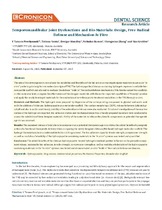Temporomandibular Joint Dysfunctions and Bio-Materials: Design, Free Radical Defense and Mechanism In Vitro

View/
Date
2015Author
Perchyonok, V Tamara
Souza, Tatiana
Moodley, Desigar
Basson, Nickolas
Zhang, Shengmiao
Grobler, Sias
Metadata
Show full item recordAbstract
The aim of this investigation is to evaluate the suitability and flexibility of the bio-active containing designer materials to act as an “in vitro” probe to gain insights into molecular origin of TMJ. The hydroxyapatite/chitosan containing hydrogels represent a reliable biocompatible scaffold and allowed to evaluate the defense “build in” free radical defense mechanism of the functionalized bio-scaffolds on the molecular level, compare the effectiveness of the designer materials with the earlier reported capabilities of N-acetyl cysteine and apply the newly developed materials for the evaluation of new therapeutic treatment modalities in the TMJ therapy in vitro.
Materials and Methods: The hydrogels were prepared by dispersion of the corresponding component in glycerol and acetic acid with the addition of chitosan: hydroxyapatite as a molecular scaffold. The surface morphology (SEM), release behaviors (physiological pH and also in acidic conditions), stability of the antioxidant-chitosan were also evaluated. Structural investigations of the reactive surface of the hydrogel are reported. Bio-adhesive studies and mechanical properties of newly prepared materials were conducted to assess the suitability of these designer materials. Ability of the materials to release the phenolic components as potential therapeutic agents was assessed.
Results: The sustained release of total phenolic component as a potential therapeutic agent confirms the added benefit of synergistic action of a functional therapeutic delivery when comparing the newly designed chitosan/HA-based hydrogel molecular scaffold. The hydrogel formulations have a uniform distribution of drug content. The bio-adhesive capacity, tensile strength, compressive strength as well as modulus of elasticity of the hydroxyapatite containing materials in the “in vitro” systems was tested and quantified.
Conclusion: The added benefits of the chitosan hydroxyapatite treated hydrogels involved positive influence on the phenolic component release, sustainable bio-adhesion, tensile strength, compressive strength as well as modulus of elasticity of the hydroxyapatite containing materials in the “in vitro” systems was tested and demonstrated in vitro “build in” free radical defense mechanism.
URI
https://www.ecronicon.com/ecde/dental-science-ECDE-02-000049.phphttp://hdl.handle.net/10566/5415
